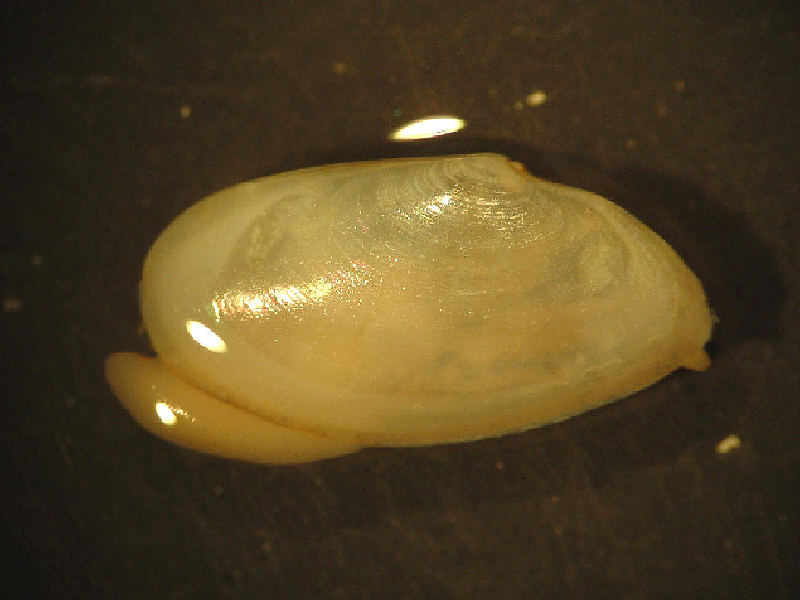Elongated furrow shell (Abra prismatica)
Distribution data supplied by the Ocean Biodiversity Information System (OBIS). To interrogate UK data visit the NBN Atlas.Map Help
| Researched by | Kelsey Lloyd | Refereed by | This information is not refereed |
| Authority | (Montagu, 1808) | ||
| Other common names | - | Synonyms | - |
Summary
Description
A bivalve with a thin and brittle oval shell up to 2.5 cm in length, and twice as long as it is deep. Both valves are similar in size and shape but are asymmetrical with the beak positioned in the posterior half of the shell pointing inwards and backwards. The outer and inner surfaces of the shell are glossy white, but the outside of the shell is covered with a brown layer (periostracum). The outside of the shell bears fine concentric lines. The inside of the shell has a pit (chondrophore) near the beak. The body bears a large and pointed foot and two slender siphons.
Recorded distribution in Britain and Ireland
Widespread around the coasts of Britain but rarely present on the western coast of Ireland.
Global distribution
Abra prismatica is widespread in the North Sea, from Norway to the Mediterranean and northwest Africa. It is also found along the south and west coasts of Iceland and the Faroes.
Habitat
Abra prismatica inhabits burrows in mixed sandy bottoms (clean sand, fine sand, and muddy sand) in the sublittoral zone from the low-water mark to about 280 m.
Depth range
Lower shore to 280 m depthIdentifying features
- Elongated oval in outline.
- Shell up to 2.5 cm in length and twice as long as it is deep.
- Shell bears fine concentric lines, visible with a hand lens.
- Both valves of the shell are similar in size and shape (equivalve).
- Valves are asymmetrical front-to-back (inequilateral).
- Both the outer and inner surface of the shell is glossy white.
- Right valve has two cardinal teeth, left valve has one small cardinal tooth.
- The periostracum is brown.
Additional information
Abra prismatica is similar to Abra alba and Abra nitida but has a more elongated shell and the top shell shifts greatly to the posterior margin of the valve. Juveniles resemble another bivalve species (Macoma calcarea) but differ with a more elongated shell, shifted top, and presence of internal ligament. Abra prismatica feeds on surface detritus.
Listed by
- none -
Bibliography
Conchological Society of Great Britain & Ireland, 2021. Molluscs. Species accounts. Conchological Society of Great Britain & Ireland. Available from: https://conchsoc.org/encyclopedia
De Kluijver, M.J., Ingalsuo, S.S. & de Bruyne, R.H., 2021. Mollusca of the North Sea. Marine Species Information Portal. Leiden, The Netherlands: ETI Bioinformatics. Available from: http://species-identification.org/species.php?species_group=mollusca&menuentry=inleiding
Deart, Y.V., Frolov, A.A. & Manushin, I.E., 2013. Bivalves Abra prismatica (Montagu, 1808) and Gari fervensis (Gmelin, 1791) — Species new to the fauna of the Russian sector of the Barents Sea. Russian Journal of Biological Invasions, 4 (3), 139-148. DOI https://doi.org/10.1134/S2075111713030028
Hayward, P.J. & Ryland, J.S. (ed.) 1995b. Handbook of the marine fauna of North-West Europe. Oxford: Oxford University Press.
Hayward, P.J. & Ryland, J.S. (ed.) 2017. Handbook of the marine fauna of North-West Europe. Oxford: Oxford University Press.
Oliver, P.G., Holmes, A.M., Killeen, I.J. & Turner, J.A., 2016. Marine Bivalve Shells of the British Isles. Amgueddfa Cymru - National Museum Wales. Available from: http://naturalhistory.museumwales.ac.uk/britishbivalves [Cited: 3 July 2018].
Tebble, N., 1976. British Bivalve Seashells. A Handbook for Identification, 2nd ed. Edinburgh: British Museum (Natural History), Her Majesty's Stationary Office.
Datasets
NBN (National Biodiversity Network) Atlas. Available from: https://www.nbnatlas.org.
OBIS (Ocean Biodiversity Information System), 2025. Global map of species distribution using gridded data. Available from: Ocean Biogeographic Information System. www.iobis.org. Accessed: 2025-07-02
Citation
This review can be cited as:
Last Updated: 21/09/2021
- Bivalve
- Mollusc
- elongate furrow shell



